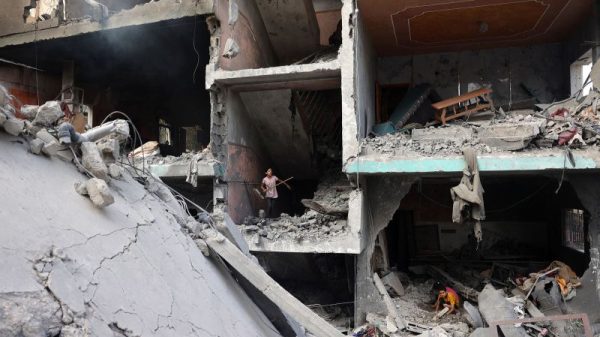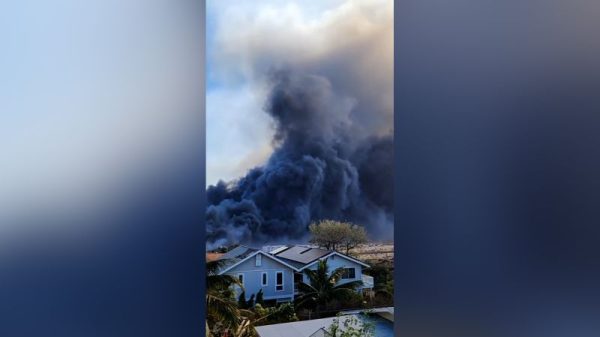From the litany of bad headlines surrounding the world of travel, you could be forgiven thinking it’s been the summer from hell for vacationers.
Environmental disasters, aviation industry mishaps and strikes, dirty beaches, soaring temperatures, deluges, price hikes and overcrowding all seem to have conspired to ruin getaways for hundreds of thousands, if not millions, of people this year.
For the most part, the inconvenience of travelers has been nothing compared to the tragic impact some of these situations have had on communities around the world.
But, for many people, a summer break is a much-needed annual highlight that offers respite from the stresses not just of everyday life, but other often extreme hardships.
Of course, huge numbers of lucky people enjoyed trouble-free vacations around the world. For every angry thread of tweets from airport departure lounges, there were likely many more smiling poolside selfies.
It’s the bad news that travels furthest. Here’s a roundup of some of the adversity that vacationers have faced over the past few months:
Relentless heat
Not everyone wants warm, sunny vacations but even sunseekers would’ve had more than they wished for in early summer, with July 2023 declared by NASA as the Earth’s hottest month since records began in 1880.
It didn’t stop there. This summer was later declared the planet’s hottest for years, breaking previous records by a significant margin.
Southern Europe sizzled as several fierce heatwaves sent temperatures soaring to near all-time highs, making life uncomfortable and even dangerous for tourists and locals alike.
In Italy, red alert heat warnings were issued alongside guidance for tourists and locals about staying hydrated and seeking out shade and aircon. In Athens, authorities closed key tourist sites including the Acropolis during the hottest part of the day.
Why your dream European vacation is already booked solid
Meanwhile, the extreme weather kept coming.
Hailstones of up to 10 centimeters, or nearly four inches, hit northern Italy’s Veneto region. Phoenix in the US endured a record-breaking 31 consecutive days of 110F-plus (43C) temperatures.
America’s national parks, particularly Death Valley, the Grand Canyon and Big Bend in Texas, sweltered, and saw several deaths suspected to be heat-related. At the Grand Canyon, QR codes were posted at trailheads linking to info on water and shelter. In Death Valley signs warned tourists not to hike after 10 a.m. Later in the summer, the same location was closed due to storm flooding.
As temperatures in parts of China soared to new records, extreme heat “tourism” saw visitors flocking to the country’s Flaming Mountains in far-western Xinjiang province to experience scorching temperatures emanating from red sandstone cliffs near Turpan.
Wearing hats and carrying umbrellas, tourists took selfies by a huge thermometer showing a surface temperature of 80 C (176 F), Chinese state television showed.
A world on fire
Inevitably, extreme heat led to extreme wildfires, with tourists and major destinations caught up in some of the worst outbreaks.
In July, blazes broke out in Portugal, Spain, Turkey and Greece, where wildfires ripped through Corfu, Evia and the outskirts of Athens.
The popular tourist island of Rhodes was most severely affected after a fire began in the centre of the island on July 18 and quickly spread to the east and south coasts, threatening beach resorts.
With flames approaching, many tourists and residents were evacuated to makeshift accommodation in sports halls, schools or public buildings on other parts of the island.
Nearly 20,000 people were evacuated by land and sea, some unable to retrieve passports and other personal effects. Airlines and tour companies cancelled flights and vacations while empty planes were sent to repatriate stranded tourists. Greece later offered free spring or fall 2024 vacations to those affected.
In August, Tenerife, one of Spain’s normally temperate Canary Islands suffered wildfires with more than 12,000 people forced to flee their homes. Fires broke out in Italy’s Sicily, Calabria, Abruzzo and Puglia regions causing evacuations from homes and hotels. Algeria, in north Africa, also suffered.
Summer is nice, but fall is better — for travel
Meanwhile Canada has experienced what experts say was its worst wildfire season in history with more than 1,000 blazes since April. Thousands of people were evacuated across the Northwest Territories and British Columbia, where travel was restricted around the popular tourist destination of Kelowna.
The most devastating wildfire of the summer hit Lahaina, the historic town popular with tourists on the Hawaiian island of Maui, on August 8, leaving at least 115 people dead. Hawaii Governor Josh Green called it the worst natural disaster in the state’s history.
Many of Lahaina’s historic and cultural landmarks were decimated by the blaze, including the Baldwin Home Museum – an 1830s-era house believed to be the oldest on Maui – the Lahaina Heritage Museum and the Wo Hing Museum.
There is hope that the sprawling 150-year-old Banyan tree – a popular focal point – may survive.
Storm forces
After the fires came the storms, again wreaking havoc on travel while also causing widespread devastation.
Hurricane Hilary crashed into the US west coast in August bringing destructive rainfall and flooding. The desert city of Palm Springs received more rainfall in an hour than it normally does in a year. At the end of summer, Idalia lashed Florida and other southern states just as the Labor Day weekend approached.
Parts of Southeast Asia were battered by a number of severe typhoons as storm season hit hard. Typhoons Doksuri, Khanun and Lan came with record rainfall and hurricane-force winds, causing deaths, severe flooding, landslides and widespread power outages.
Typhoon Khanun also lashed South Korea with deadly force and led to nearly 40,000 teenagers from 155 countries cutting short the World Scout Jamboree in Saemangeum, south of Seoul, when the threat of the approaching typhoon added to problems caused by the heatwave and conditions at the campsite.
When Typhoon Lan hit Japan’s southern Wakayama prefecture on August 15, super-fast bullet trains were heavily disrupted. Japan Airlines and All Nippon Airways also scrapped a host of flights.
Overrun Amsterdam targets sex and drugs tourists with ‘stay away’ campaign
In hot water
Another consequence of rising heat has been water temperatures also reaching record highs.
While hot tub temperatures of 101.19 F (38.44 C), instead of the usual 80F, recorded on July 25 in Florida’s Manatee Bay might’ve made it uncomfortable for swimmers, they also caused unprecedented mass bleaching and threatened the extinction of coral species on reefs around the Florida Keys.
One report from the Coral Restoration Foundation found “100% coral mortality” at Sombrero Reef off the coast of Marathon in the Florida Keys.
Coral reefs generate billions of dollars for Florida’s economy through fishing and tourism and providing jobs.
And it wasn’t just Florida. The Mediterranean Sea reached a record high of 83.1F (28.4C) on July 24, according to the European Copernicus Climate Change Service (C3S). The previous record was 28.25C (82.85F) set in 2003.
Americans are flocking to Europe’s hot spots. Here’s where Europeans are going instead
Dirty water
In stark contrast to the searing heat in southern Europe, the UK endured a prolonged spell of mixed and wet weather in July and August, washing out many summer breaks and other sporting and cultural events in Britain. Temperatures only rose in early September when most people’s vacations were over.
Experts said the unseasonal weather was down to a blocked weather pattern caused by a kink in the jet stream, the wind that blows west to east high up in the atmosphere.
Perhaps an absence of beach weather was a good thing, with British beachgoers and watersports enthusiasts battling increasing issues with water quality because increased sewage dumping at sea is leaving many shorelines too toxic for swimmers.
Sewage-covered beaches risk turning England into the ‘dirty man of Europe’
Flight chaos
While the frequently creaking US aviation infrastructure held it together over the summer, in Europe there were numerous disruptive events with strikes or threats of strikes by air traffic controllers, pilots or cabin crew leading to thousands of flights being scrapped.
In late August, an air traffic control glitch blamed on a single erroneous data point led to UK’s National Air Traffic Services restricting traffic, causing widespread delays and cancellations across the continent for days.
The UK has also been hit by an ongoing series of rail strikes in 2023, affecting travelers and commuters alike, while waits at UK international ferry terminals such as Dover have become longer than the pre-Brexit era because of extra time needed for passport control.
Overcrowding and overpricing
Despite the hazards and hitches across the globe, tourists were still travelling in droves, perhaps as a rebound from Covid lockdowns. In fact, in some places there were so many visitors that authorities felt the need to limit their numbers.
In France, sites such as the spectacular Mont Saint Michel, have been so overwhelmed there are campaigns to send tourists elsewhere or spread visits out over the year. Amsterdam launched an unusual “stay away campaign” in an attempt to curb visits from rowdy young Brits and, along with Venice, considered restrictions on cruise ships. On Japan’s sacred Mount Fuji, crowds were so bad tourists had to line up to reach the summit.
$2 to cut a sandwich in half: The outrageous rip-offs targeting tourists in Italy
Venice, meanwhile, has announced a new 5 euro ($5.40) entry fee for daytrippers to cut numbers. And Greek officials say the number of daily visitors to the Acropolis will be limited from September to preserve the monument.
On the Spanish vacation island of Mallorca, a local protest group has claimed to be behind fake signs warning of jellyfish, falling rocks or long walks to reach a nearby beach, saying it’s using them to try to limit overcrowding.
Crowds of tourists have been an easy target for scammers in Italy, where visitors have faced rip-off charges for services like cutting a sandwich in half. Meanwhile many locals say their own country is too expensive for a vacation.







































